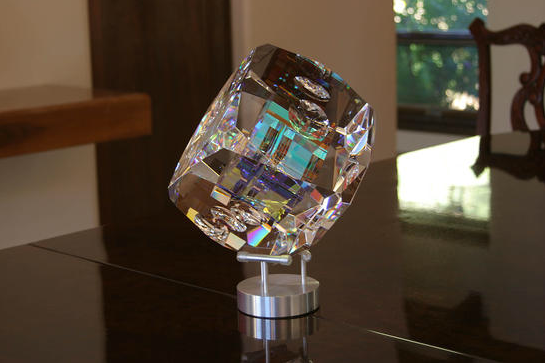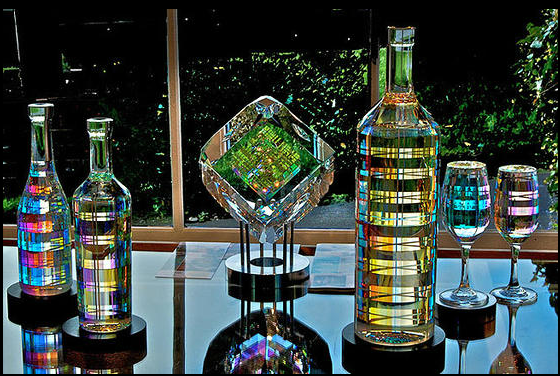It's unusual to use glass in art. But it's this same exact quality which has endeared it to many artists and art lovers worldwide. Maybe it's this material's fragility which makes for compelling pieces; or its translucent attribute that has mesmerized people through the ages. One thing is certain: glass art and sculptures will always have a place in society.
A Brief History
The ones who should be credited for developing glass are the Assyrians and Egyptians. Its use for art wasn't until the Romans brought it to Europe where glassblowing and other techniques were refined to make way for ornaments and other functional pieces.
Murano, a series of islands in the Venetian Lagoon (Italy), is known as the birthplace of modern glass art. That's because this was where the Romans initially settled during the sixth century. Among their greatest triumphs with this medium is the popularity of stained glass; which until now adorns many cathedrals and lavish European homes.
Until today, glass from Murano (also called Venetian glass) remains as one of the best glass products in the world after hundreds of years of cultivation.
Glass as Art
It wasn't until the 19th century that glass products were mass produced from factories using mechanical methods. Before, master craftsmen and factory workers toiled day and night to manufacture all kinds of items for utility and decorative functions.
The modern use of glass in art is called 'studio glass' or glass sculptures. An artist makes three dimensional pieces utilizing various glass-making strategies; creating stunning works in different sizes. Most of these objects are showcased in museums and public establishments; although it's not rare to find awesome items as collectibles in private homes and offices.
The ones who should be credited for developing glass are the Assyrians and Egyptians. Its use for art wasn't until the Romans brought it to Europe where glassblowing and other techniques were refined to make way for ornaments and other functional pieces.
Murano, a series of islands in the Venetian Lagoon (Italy), is known as the birthplace of modern glass art. That's because this was where the Romans initially settled during the sixth century. Among their greatest triumphs with this medium is the popularity of stained glass; which until now adorns many cathedrals and lavish European homes.
Until today, glass from Murano (also called Venetian glass) remains as one of the best glass products in the world after hundreds of years of cultivation.
Glass as Art
It wasn't until the 19th century that glass products were mass produced from factories using mechanical methods. Before, master craftsmen and factory workers toiled day and night to manufacture all kinds of items for utility and decorative functions.
The modern use of glass in art is called 'studio glass' or glass sculptures. An artist makes three dimensional pieces utilizing various glass-making strategies; creating stunning works in different sizes. Most of these objects are showcased in museums and public establishments; although it's not rare to find awesome items as collectibles in private homes and offices.
How It's Made
There are all kinds of methods for making glass art; the most notable of them being glass-blowing. This is done by inflating molten glass into a bubble through a long blowpipe. This causes the material to expand, giving it a definite shape and form.
Lampworking is another technique by which a torch or lamp is used to manipulate glass. Also known as lampworking or torchworking; this requires great skill and precision on the part of the artist. When combined with glassblowing, it can produce wonderfully whimsical pieces like glass ball ornaments, beads, marbles, and figurines.
Glass fusing on the other hand, involves heating two or more pieces of glass until it melts and fuses together. It's quite a popular approach since it doesn't need much skill or space. Anyone can master the methods rather easily as compared to other glass-making techniques.
Casting refers to the use of molds where molten glass can be turned into marvelous works of art. It's one of the oldest processes used since Egyptian times and is still being practiced today. Casts can be made from sand, graphite, or metal molds.
Glass adds a different depth and dimension to artworks not found in other traditional materials. Perhaps it is this particular feature which holds this crystal substance so close to the human heart.
There are all kinds of methods for making glass art; the most notable of them being glass-blowing. This is done by inflating molten glass into a bubble through a long blowpipe. This causes the material to expand, giving it a definite shape and form.
Lampworking is another technique by which a torch or lamp is used to manipulate glass. Also known as lampworking or torchworking; this requires great skill and precision on the part of the artist. When combined with glassblowing, it can produce wonderfully whimsical pieces like glass ball ornaments, beads, marbles, and figurines.
Glass fusing on the other hand, involves heating two or more pieces of glass until it melts and fuses together. It's quite a popular approach since it doesn't need much skill or space. Anyone can master the methods rather easily as compared to other glass-making techniques.
Casting refers to the use of molds where molten glass can be turned into marvelous works of art. It's one of the oldest processes used since Egyptian times and is still being practiced today. Casts can be made from sand, graphite, or metal molds.
Glass adds a different depth and dimension to artworks not found in other traditional materials. Perhaps it is this particular feature which holds this crystal substance so close to the human heart.


 RSS Feed
RSS Feed